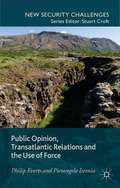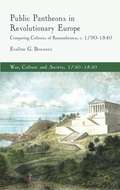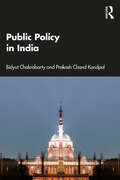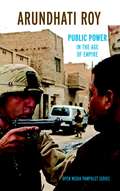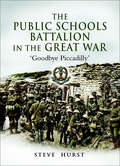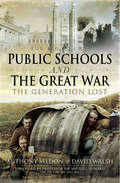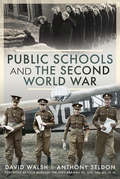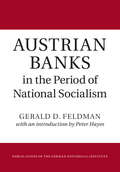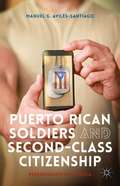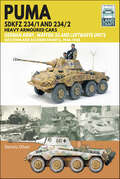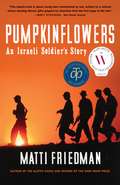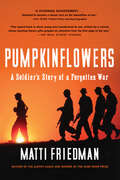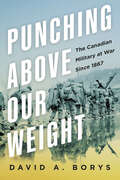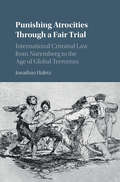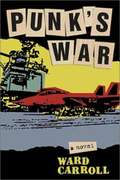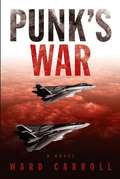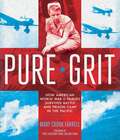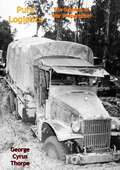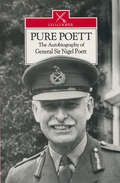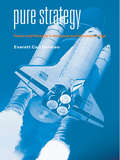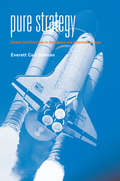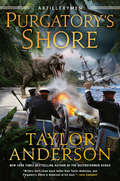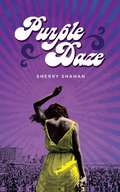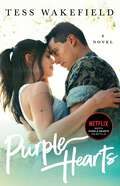- Table View
- List View
Public Opinion, Transatlantic Relations and the Use of Force
by Philip Everts Pierangelo IserniaThis book explores the intersection of the study of transatlantic relationships and the study of public support for the use of force in foreign policy. It contributes to two important debates: one about the nature of transatlantic partnership, and another about the determinants of support for the use of military force in a comparative perspective.
Public Pantheons in Revolutionary Europe
by Eveline G. BouwersThe story of how the concept of a pantheon, a building honouring great individuals, spread across Revolutionary Europe and interacted with socio-political and cultural changes. Analysing the canon and iconography of each pantheon, Bouwers shows how the commemoration of war and celebration of nationhood gave way to the protection of elite interests.
Public Policy in India
by Bidyut Chakrabarty Prakash Chand KandpalThis textbook is a comprehensive, student-friendly guide to public policy in India. It highlights the critical aspects of public policy-making and its implementation by contextualizing it in the Indian historical and modern-day perspective. Public Policy in India: • Provides lucid explanations of theoretical aspects of public policy and its practice in the Indian context; • Captures the complexities in making, implementing and evaluating public policy; • Studies the dialectical interconnection that public policy has with the socio-economic and political environment; • Highlights the influence of culture on public policy; and • Analyses public policy as an outcome of a very complex contextual dialogue involving various kinds of actors. Accessibly written, this book covers a range of university syllabi and will be essential reading for students and researchers of political science and public administration. It will also be indispensable for civil service examinations, including the UPSC.
Public Power in the Age of Empire (Open Media Series)
by Arundhati RoyIn her major address to the 99th annual meeting of the American Sociological Association on August 16, 2004, "Public Power in the Age of Empire," broadcast nationally on C-Span Book TV and on Democracy Now! and Alternative Radio, writer Arundhati Roy brilliantly examines the limits to democracy in the world today. Bringing the same care to her prose that she brought to her Booker Prize-winning novel The God of Small Things, Roy discusses the need for social movements to contest the occupation of Iraq and the reduction of "democracy" to elections with no meaningful alternatives allowed. She explores the dangers of the "NGO-ization of resistance," shows how governments that block nonviolent dissent in fact encourage terrorism, and examines the role of the corporate media in marginalizing oppositional voices.
Public Schools Battalion in the Great War
by Steve HurstFounded in August 1914 with the principle that recruiting would be restricted to public school old boys, the volunteers gathered at Hurst Park racecourse in a spirit of youthful enthusiasm. A more somber mood soon set in. Despite many of the original volunteers leaving to take commissions in other regiments the battalion, now officially the 7th Middlesex, remained an elite until its disbandment in 1917.The climax of the Battalions war came on 1 July 1916. Close to the Hawthorn Redoubt Crater are two cemeteries sited on either side of the Auchonvilliers Beaumont Hamel road. They contain row upon row of stones marking the graves of members of the Public Schools Battalion.The author, shocked by this discovery, has spent ten years researching the history of the Battalion and the events of that fateful day as they affected it. The result is a fascinating and moving record of a very uniquely British battalion.
Public Schools and The Great War: The Generation Lost
by David Walsh Anthony SeldonIn this pioneering and original book, Anthony Seldon and David Walsh study the impact that the public schools had on the conduct of the Great War, and vice versa. Drawing on fresh evidence from 200 leading public schools and other archives, they challenge the conventional wisdom that it was the public school ethos that caused needless suffering on the Western Front and elsewhere. They distinguish between the younger front-line officers with recent school experience and the older 'top brass' whose mental outlook was shaped more by military background than by memories of school.The Authors argue that, in general, the young officers' public school education imbued them with idealism, stoicism and a sense of service. While this helped them care selflessly for the men under their command in conditions of extreme danger, it resulted in their death rate being nearly twice the national average.This poignant and thought-provoking work covers not just those who made the final sacrifice, but also those who returned, andwhose lives were shattered as a result of their physical and psychological wounds. It contains a wealth of unpublished detail about public school life before and during the War, and how these establishments and the country at large coped with the devastating loss of so many of the brightest and best. Seldon and Walsh conclude that, 100 years on, public school values and character training, far from being concepts to be mocked, remain relevant and that the present generation would benefit from studying them and the example of their predecessors.Those who read Public Schools and the Great War will have their prevailing assumptions about the role and image of public schools, as popularised in Blackadder, challenged and perhaps changed.
Public Schools and the Second World War
by David Walsh Anthony SeldonA historical analysis of the contribution of Great Britain’s public schools to the conduct of World War II.Following their ground-breaking book on Public Schools and the Great War, David Walsh and Anthony Seldon now examine how those same schools fared in the Second World War. They use eye-witness testimony to recount stories of resilience and improvisation in 1940 as the likelihood of invasion and the terrors of the Blitz threatened the very survival of public schools. They also assess the giant impact that public school alumni contributed to every aspect of the war effort.The authors examine how the “People’s War” brought social cohesion, with the opportunity to end public school exclusiveness to the fore, encouraged by Winston Churchill among others. That opportunity was ironically squandered by the otherwise radical Clement Attlee’s post-war Labour government, prolonging the “public school problem” right through to the present day.The public schools shaped twentieth century history profoundly, never more so than in the conduct of both its world wars. The impact of the schools on both wars was very different, as were the legacies. Drawing widely on primary source material and personal accounts of inspiring courage and endurance, this book is full of profound historical reflection and is essential reading for all who want to understand the history of modern Britain.
Public Schools and the Second World War
by David Walsh Anthony SeldonA historical analysis of the contribution of Great Britain’s public schools to the conduct of World War II.Following their ground-breaking book on Public Schools and the Great War, David Walsh and Anthony Seldon now examine how those same schools fared in the Second World War. They use eye-witness testimony to recount stories of resilience and improvisation in 1940 as the likelihood of invasion and the terrors of the Blitz threatened the very survival of public schools. They also assess the giant impact that public school alumni contributed to every aspect of the war effort.The authors examine how the “People’s War” brought social cohesion, with the opportunity to end public school exclusiveness to the fore, encouraged by Winston Churchill among others. That opportunity was ironically squandered by the otherwise radical Clement Attlee’s post-war Labour government, prolonging the “public school problem” right through to the present day.The public schools shaped twentieth century history profoundly, never more so than in the conduct of both its world wars. The impact of the schools on both wars was very different, as were the legacies. Drawing widely on primary source material and personal accounts of inspiring courage and endurance, this book is full of profound historical reflection and is essential reading for all who want to understand the history of modern Britain.
Publications of the German Historical Institute: Austrian Banks in the Period of National Socialism
by Gerald D. FeldmanThis book is the English translation of Gerald D. Feldman's contributions to the multi-author, two-volume study sterreichische Banken und Sparkassen im Nationalsozialismus und in der Nachkeriegszeit, which was originally published in German by C. H. Beck in 2006. Austrian Banks in the Period of National Socialism focuses on the activities of two major financial institutions, the Creditanstalt-Wiener Bankverein and the Lnderbank Wien. It details the ways the two banks served the Nazi regime and how they used the opportunities presented by Nazi rule to expand their business activities. Particular attention is given to the role that the Creditanstalt and Lnderbank played in the 'Aryanization' of Jewish-owned businesses. The book also examines the two banks' relations with their industrial clients and considers the question of whether bank officials had any knowledge of their client firms' use of concentration camp prisoners and other forced laborers during World War II.
Puerto Rican Soldiers and Second-Class Citizenship: Representations in Media
by Manuel G. Avilés-SantiagoPuerto Rican soldiers have been consistently whitewashed out of the narrative of American history despite playing parts in all American wars since WWI. This book examines the online self-representation of Puerto Rican soldiers who served during the War on Terror, focusing on social networking sites, user-generated content, and web memorials.
Puma Sdkfz 234/1 and Sdkfz 234/2 Heavy Armoured Cars: German Army and Waffen-SS, Western and Eastern Fronts, 1944–1945 (LandCraft)
by Dennis Oliver"....a well-researched title that covers a lesser known type and that manages to squeeze a heck of a lot into 64 pages." —WarWheels The lightning advances of the German armored units during the Polish and French campaigns were spearheaded by fast-moving, armed reconnaissance vehicles. But these early designs suffered heavily due to their light weaponry and thin armor and a program was soon underway, led by the firm of Büssing-NAG, which culminated in the development of the Sdkfz 234 series of heavy eight-wheeled armored cars, the first of which entered service in late 1943. These vehicles proved to be rugged and reliable and were gradually up-armed to serve in the infantry support role and eventually as tank killers. This volume of the LandCraft series concludes the story of the Sdkfz 234 series, examining the versions that took part in the last battles of the war. Using archive photos and extensively researched color illustrations Dennis Oliver examines the Sdkfz 234/1 and Sdkfz 234/2 and the units that operated these often neglected, yet important, armored vehicles. A key section of his book displays available model kits and aftermarket products, complemented by a gallery of beautifully constructed and painted models in various scales. Technical details as well as modifications introduced during production and in the field are also examined, providing everything the modeler needs to recreate an accurate representation of these historic tanks.
Pumpkinflowers
by Matti FriedmanFrom an award-winning Canadian-Israeli writer comes the true story of a band of young soldiers, the author among them, charged with holding one remote outpost in Lebanon, a task that changed them forever and foreshadowed today's unwinnable conflicts in Iraq, Afghanistan, and elsewhere.It was small hilltop in a small, unnamed war in the late 1990s, but it would send out ripples that continue to emanate worldwide today. The hill was called the Pumpkin flowers was the military code word for "casualties." Friedman's visceral narrative recreates harrowing wartime experiences in a work that is part frontlines memoir, partjournalistic reporting, part military history. The years in question were pivotal ones, and not just for Israel. They saw the perfection of a type of warfare that would eventually be exported to Afghanistan and Iraq. The new twenty-first century war is one in which there is never any clear victor, and not enough lives are lost to rally the public against it. Eventually Israel would come to realize that theirs was a losing proposition and pull out. But, of course, by then these soldiers--those who had survived--and the country had been wounded in ways large and small. Raw, powerful, beautifully rendered, the book will take its place among classic war stories such as those by George Orwell, Philip Caputo, and Vasily Grossman. Pumpkinflowers is an unflinching look, like the works of Jon Krakauer and Sebastian Junger, at the way we conduct war today.From the Hardcover edition.
Pumpkinflowers: A Soldier's Story
by Matti Friedman“A book about young men transformed by war, written by a veteran whose dazzling literary gifts gripped my attention from the first page to the last.” —The Wall Street Journal “Friedman’s sober and striking new memoir . . . [is] on a par with Tim O’Brien’s The Things They Carried -- its Israeli analog.” —The New York Times Book Review It was just one small hilltop in a small, unnamed war in the late 1990s, but it would send out ripples that are still felt worldwide today. The hill, in Lebanon, was called the Pumpkin; flowers was the military code word for “casualties.” Award-winning writer Matti Friedman re-creates the harrowing experience of a band of young Israeli soldiers charged with holding this remote outpost, a task that would change them forever, wound the country in ways large and small, and foreshadow the unwinnable conflicts the United States would soon confront in Afghanistan, Iraq, and elsewhere.Pumpkinflowers is a reckoning by one of those young soldiers now grown into a remarkable writer. Part memoir, part reportage, part history, Friedman’s powerful narrative captures the birth of today’s chaotic Middle East and the rise of a twenty-first-century type of war in which there is never a clear victor and media images can be as important as the battle itself. Raw and beautifully rendered, Pumpkinflowers will take its place among classic war narratives by George Orwell, Philip Caputo, and Tim O’Brien. It is an unflinching look at the way we conduct war today.
Punching Above Our Weight: The Canadian Military at War Since 1867
by David A. Borys“Quick-paced, well-researched and well-illustrated, this is the first new history of Canada’s armed forces in decades.” — J. L. Granatstein, author of Canada’s ArmyPunching Above Our Weight takes readers on a riveting exploration spanning one hundred and fifty years of Canadian forces. This photograph-rich history of 150 years of the Canadian military traces the evolution of the country’s armed forces from a small, underfunded, poorly trained militia to the modern, effective military it is today. From the Red River Resistance and the Boer War to modern peacekeeping and the long war in Afghanistan, David A. Borys details the conflicts and operations that Canadian soldiers have served in. He highlights the key battles, decisive moments, and significant people that came to define Canada’s participation and helped cement its global reputation. Borys also explores the challenges that the Canadian nation and its military have faced over those years, including major cultural and demographic shifts, a continual struggle for resources from generally disinterested governments, battlefield failures, notorious and shocking scandals, along with ever-changing global threats.Punching Above Our Weight brings to light a new perspective on the Canadian military and its place in the world over the past one hundred and fifty years.
Punishing Atrocities through a Fair Trial: International Criminal Law From Nuremberg To The Age Of Global Terrorism
by Jonathan HafetzOver the past decades, international criminal law has evolved to become the operative norm for addressing the worst atrocities. Tribunals have conducted hundreds of trials addressing mass violence in the former Yugoslavia, Rwanda, Sierra Leone, Cambodia, and other countries to bring to justice perpetrators of genocide, war crimes, and crimes against humanity. <P><P>But international courts have struggled to hold perpetrators accountable for these offenses while still protecting the fair trial rights of defendants. Punishing Atrocities through a Fair Trial explores this tension, from criticism of the Nuremberg Trials as 'victor's justice' to the accusations of political motivations clouding prosecutions today by the International Criminal Court. It explains why international criminal law must adhere to transparent principles of legality and due process to ensure its future as a legitimate and viable legal regime.<P> Provides a new framework for conceptualizing developments in international criminal law.<P> Discusses various aspects of fairness in international criminal proceedings.<P> Highlights the tension between accountability and due process when prosecuting atrocities.<P>
Punk's War
by Ward CarrollAn F-14 aviator takes his readers into the cockpits, ready-rooms, and bunkrooms of today's Navy to show what it's like to fight in a time of so-called peace.
Punk's War
by Ward CarrollAn F-14 aviator takes his readers into the cockpits, ready-rooms, and bunkrooms of today's Navy to show what it's like to fight in a time of so-called peace. From the opening chapter where a Tomcat fighter squadron's commanding officer botches an intercept of a hostile Iranian F-4 to the final uplifting scene, his novel reveals the inner workings of the military as only an insider can. It is a thriller without an airshow groupie's pretense, a fighter pilot's story as honest as it is riveting. The action is gripping and authentic, yet it punctuates rather than drives the plot. Seldom has fiction been so real.Punk's War is part adventure tale, part introspective commentary. Adopting the tone of the quixotic lieutenants who populate its pages, the novel helps us understand the pressures on this new generation of warfighters. Along the way we are introduced to an engaging cast of characters: a self-centered careerist squadron commander hell-bent on fixing his tainted professional reputation; a reluctant air-wing commander more suited for life within the walls of the Pentagon than on a flight deck at sea; a battle-group commander reared in the art of driving ships, but thrust into the snap decision matrix of supersonic jets; and a host of junior officers. Seeking only the ideals they were promised, these technology-savvy aviators are products of pop culture, unimpressed by rank for its own sake and unresponsive to petitions in the name of the profession's lofty mottos. Unlike other books about the business of flying from aircraft carriers, this novel provides serious food for thought about leadership and retention--what motivates young people to keep doing what they do despite the dangers, disappointments, and personal sacrifices. Best-selling novelist Stephen Coonts describes the author as Tom Clancy crossed with Joseph Heller, his book as a refreshing twist on the military thriller.
Pure Grit: How American World War II Nurses Survived Battle and Prison Camp in the Pacific
by Mary Cronk FarrellIn the early 1940s, young women enlisted for peacetime duty as U.S. Army nurses. But when the Japanese attack on Pearl Harbor in 1941 blasted the United States into World War II, 101 American Army and Navy nurses serving in the Philippines were suddenly treating wounded and dying soldiers while bombs exploded all around them. The women served in jerry-rigged jungle hospitals on the Bataan Peninsula and in underground tunnels on Corregidor Island. <p><p> Later, when most of them were captured by the Japanese as prisoners of war, they suffered disease and near-starvation for three years. Pure Grit is a story of sisterhood and suffering, of tragedy and betrayal, of death and life. The women cared for one another, maintained discipline, and honored their vocation to nurse anyone in need―all 101 coming home alive.
Pure Logistics: The Science of War Preparation
by George Cyrus ThorpeWe place a premium on forward-looking military thought, but a reflective look at literature from the past can also be useful, especially when that literature marks the intellectual heritage of American planning for national defense.At the Industrial College of the Armed Forces, one of the accepted classics of military literature is Pure Logistics: The Science of War Preparation, written by Lieutenant-Colonel George C. Thorpe of the United States Marine Corps and published originally in 1917…Stanley L. Falk tells us Pure Logistics stands out as a milestone between the seminal writings of Baron de Jomini, published one hundred years before, and later treatises examining logistics following World War II. Thorpe’s observations and recommendations in Pure Logistics have held up over time, even in the face of the technological advances of nearly seventy years. His call for preparation in peacetime to accelerate defense industrial production in the event of war is as valid today as it was in 1917.
Pure Poett: The Autobiography of General Sir Nigel Poett
by Nigel PoettThis is the story of a professional soldier and of his many adventures throughout the world. His father was a soldier, and it was no surprise when young Nigel Poett went to Sandhurst and then to Egypt, the North-West Frontier, India, Japan, Australia and New Zealand. His long career included appointment as Director of Military Operations in the Suez crisis and Commandant-General of Staff College, and ended with his command of the Far East Land Forces. Possibly the most eventful period, however, was when, as an Airborne Brigadier, he was given the task of commanding the airborne assault on the two vital bridges over the Orne which had to be captured to secure the left flank of the Normandy Invasion front.
Pure Strategy: Power and Principle in the Space and Information Age
by Everett DolmanA stimulating new inquiry into the fundamental truth of strategy - its purpose, place, utility, and value. This new study is animated by a startling realization: the concept of strategic victory must be summarily discarded. This is not to say that victory has no place in strategy or strategic planning. The outcome of battles and campaigns are variables within the strategist's plan, but victory is a concept that has no meaning there. To the tactical and operational planner, wars are indeed won and lost, and the difference is plain. Success is measurable; failure is obvious. In contrast, the pure strategist understands that war is but one aspect of social and political competition, an ongoing interaction that has no finality. Strategy therefore connects the conduct of war with the intent of politics. It shapes and guides military means in anticipation of a panoply of possible coming events. In the process, strategy changes the context within which events will happen. In this new book we see clearly that the goal of strategy is not to culminate events, to establish finality in the discourse between states, but to continue them; to influence state discourse in such a way that it will go forward on favorable terms. For continue it will. This book will provoke debate and stimulate new thinking across the field and strategic studies.
Pure Strategy: Power and Principle in the Space and Information Age (Strategy and History)
by Everett DolmanA stimulating new inquiry into the fundamental truth of strategy - its purpose, place, utility, and value. This new study is animated by a startling realization: the concept of strategic victory must be summarily discarded. This is not to say that victory has no place in strategy or strategic planning. The outcome of battles and campaigns are variables within the strategist's plan, but victory is a concept that has no meaning there. To the tactical and operational planner, wars are indeed won and lost, and the difference is plain. Success is measurable; failure is obvious. In contrast, the pure strategist understands that war is but one aspect of social and political competition, an ongoing interaction that has no finality. Strategy therefore connects the conduct of war with the intent of politics. It shapes and guides military means in anticipation of a panoply of possible coming events. In the process, strategy changes the context within which events will happen. In this new book we see clearly that the goal of strategy is not to culminate events, to establish finality in the discourse between states, but to continue them; to influence state discourse in such a way that it will go forward on favorable terms. For continue it will. This book will provoke debate and stimulate new thinking across the field and strategic studies.
Purgatory's Shore (Artillerymen #1)
by Taylor AndersonOn their way to fight in the Mexican-American War, a group of American soldiers are swept away to a strange and deadly alternate Earth in this thrilling new adventure set in the world of the New York Times bestselling Destroyermen series.The United States, 1847. A disparate group of young American soldiers are bound to join General Winfield Scott's campaign against Santa Anna at Veracruz during the Mexican-American War. They never arrive.Or rather . . . they arrive somewhere else.The untried, idealistic soldiers are mostly replacements, really; a handful of infantry, artillery, dragoons, and a few mounted riflemen with no unified command. And they've been shipwrecked on a terrible, different Earth full of monsters and unimaginable enemies. Major Lewis Cayce, late of the 3rd US "Flying" Artillery, must unite these men to face their fears and myriad threats, armed with little more than flintlock muskets, a few pieces of artillery, and a worldview that spiritually and culturally rebels against virtually everything they encounter. It will take extraordinary leadership and a cadre of equally extraordinary men and women to mold frightened troops into an effective force, make friends with other peoples the evil Holy Dominion would eradicate, and reshape their "manifest destiny" into a cause they can all believe in and fight for.For only together will they have any hope of survival.
Purple Daze
by Sherry ShahanPurple Daze is a young adult novel set in suburban Los Angeles in 1965. Six high school students share their experiences and feelings in interconnected free verse and traditional poems about war, feminism, riots, love, racism, rock 'n' roll, high school, and friendship. Although there have been verse novels published recently, none explore the changing and volatile 1960's in America-- a time when young people drove a cultural and political revolution. With themes like the costs and casualties of war, the consequences of sex, and the complex relationships between teens, their peers, and their parents, this story is still as relevant today as it was 45 years ago.
Purple Hearts: A Novel
by Tess WakefieldNOW A NETFLIX ORIGINAL FILM! When a soldier with a troubled past and a struggling songwriter agree to a marriage of convenience for the military benefits, neither expects much after saying &“I do.&” Then tragedy strikes, and the line between what&’s real and what&’s pretend begins to blur in this smart and surprising romance perfect for fans of Nicholas Sparks and Jojo Moyes.Cassie Salazar and Luke Morrow couldn&’t be more different. Sharp-witted Cassie works nights at a bar in Austin, Texas to make ends meet while pursuing her dream of becoming a singer/songwriter. Luke is an Army trainee, about to ship out for duty, who finds comfort in the unswerving discipline of service. But a chance encounter at Cassie&’s bar changes the course of both their lives. Cassie is drowning in medical bills after being diagnosed with diabetes. When she runs into her old friend Frankie, now enlisted in the Army, she proposes a deal: she&’ll marry him in exchange for better medical insurance and they can split the increased paycheck that comes with having a &“family.&” When Frankie declines, his attractive but frustratingly intense friend Luke volunteers to marry Cassie instead. What she doesn&’t know is that he has desperate reasons of his own to get married. In this unforgettable love story, Cassie and Luke must set aside their differences to make it look like a real marriage...unless, somewhere along the way, it becomes one...
